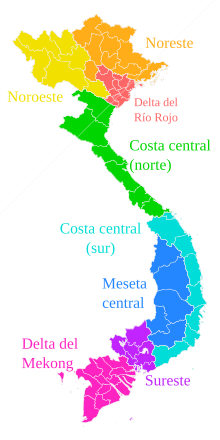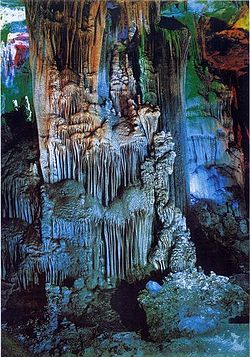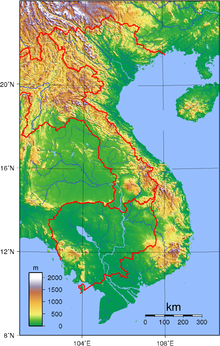Vietnamese geography
The geography of Vietnam or the Socialist Republic of Vietnam deals with the relief, hydrology and climate of this country, which has an area of 333,000 km² and more than 96 million inhabitants.
It borders China to the north, Laos (northern half) and Cambodia (southern half) to the west, and is washed by the South China Sea to the east and south. The relief is very mountainous and rugged.
The two most important freshwater courses are the Red rivers, to the north, and Mekong, to the south, in their deltas most of the population lives. The Red River flows directly southeast from the mountainous regions of the northeast, while the Mekong flows irregularly from Cambodia and empties into the South China Sea. Both rivers have been channeled to avoid possible damage caused by flooding.
Relief
Vietnam is roughly divided into the mountainous areas and the Red River Delta in the north, and the southern mountains, known as the Central Highlands, the coastal lowlands, and the Mekong River Delta in the south.
Red River Delta
The Red River Delta is a triangular region of 15,000 km² that is heavily cultivated and more densely populated than the Mekong River Delta. Formed in the Gulf of Tonkin by alluvial deposits left by rivers over millennia, the delta advances a hundred meters into the gulf annually. It is the ancestral home of the Vietnamese ethnic group, where 70 percent of North Vietnam's agriculture and 80 percent of its industry was concentrated before 1975.
The Red River, which originates in the Chinese province of Yunnan, is 1,200 km long. Its two main tributaries, the Negro River and the Lô River, contribute to its large volume of water, some 4,300 m³/s. The entire region of the delta, at the foot of the forested mountains, does not exceed 3 m above sea level, and much of it is 1 m or less. The area is subject to frequent flooding, and in some places the water marks reach 14 meters. For centuries, flood control has been part of the local culture, and an extensive system of dikes and canals has been built to control floods and maintain rice cultivation. Following the Chinese model, high population density and a double rice crop have been achieved in more than half of the region.
Northern Mountains
The northern and northwestern mountains and plateaus are inhabited by minority tribal groups. The Annamite mountain range originates in northwestern China, is more than 1,100 km long, and forms the Vietnamese border with Laos. It ends in the Mekong River Delta, north of Ho Chi Minh City.
The central part of these mountains, which have several plateaus, are irregular in height and shape. The northern zone is narrow and very wild; the country's highest peak, Fansipan (3,143 m), is located in the far northwest. The southern portion has numerous foothills that divide the narrow coastal strip into a series of compartments. For centuries, these topographical features have made communications difficult and formed a natural barrier to prevent mixing with the populations of the Mekong River basin.
Central Highlands
Within the southern portion of Vietnam is a plateau known as the Central Highlands that is approximately 51,800 km² of rugged mountain peaks, extensive forests, and rich soils. It comprises 5 relatively flat plateaus of basaltic soil that span Đắk Lắk, Gia Lai and Kon Tum provinces, covering 16 percent of the arable land and 22 percent of the country's forests. Until 1975, North Vietnam considered the Central Highlands and the Annamite Range strategic areas of great importance essential not only for the dominance of South Vietnam but also for part of southern Indochina. Since 1975, the highlands have served to relocate people from the overcrowded lowlands.
Coastal Plain
A narrow, flat coastal strip stretches from the Red River Delta to the Mekong River Delta. In the inland area, the mountains rush over the coast, reaching in some cases to the sea. This narrow strip is very fertile and is intensively cultivated with rice.
Mekong River Delta
The Mekong River Delta covers an area of 40,000 km²; It is an extensive plain of no more than 3 m above sea level, crossed by rivers and canals. The sediments carried by the different branches and tributaries of the Mekong River make the delta advance 6 to 8 m per year. It is estimated that one thousand million cubic meters of sediments flow, about thirteen times the amount deposited by the Red River. Some 10,000 km² of the delta are cultivated with rice, one of the largest paddy fields in the world. The southern tip, known as the Ca Mau province or peninsula, is covered in dense jungle and mangrove swamps.
The Mekong River is 4,220 km long. It is born in Tibet and forms the border between Laos and Burma, then between Laos and Thailand and then crosses Cambodia. At Phnom Penh it merges with the river coming from Tonlé Sap Lake, of the same name, and divides into two branches, the Hậu Giang River, known as the Bassac River in Cambodia, and the Tiền River, then flows through southern Cambodia and continues the Mekong Basin until it empties into the South China Sea through nine mouth channels known as the Nine Dragons (Cửu Long). The river is very silty, but it is navigable for shallow boats from the city of Kompung Cham. The Tonlé Sap river that joins the Mekong in Phnom Penh acts as a natural reservoir to stabilize floods, since when the Mekong is very swollen and the delta cannot absorb the enormous amount of water, it flows backwards towards Tonlé lake. Sap and floods an area of 10,000 km². When the flood subsides, the lake's water flows back into the Mekong. This effect reduces the flooding that the Mekong would cause, which still floods the surrounding fields with 2 m of water.
Climate
| Vietnam Climogram | |||||||||||||||||||||||||||||||||||||||||||||||
|---|---|---|---|---|---|---|---|---|---|---|---|---|---|---|---|---|---|---|---|---|---|---|---|---|---|---|---|---|---|---|---|---|---|---|---|---|---|---|---|---|---|---|---|---|---|---|---|
| E | F | M | A | M | J | J | A | S | O | N | D | ||||||||||||||||||||||||||||||||||||
19
20 12 | 27
21 13 | 39
24 18 | 80
29 21 | 198
32 22 | 240
33 25 | 322
32 26 | 345
32 25 | 250
31 24 | 99
28 23 | 44
25 19 | 21
21 16 | ||||||||||||||||||||||||||||||||||||
| temperatures in °C • total precipitation in mm Source: [1] | |||||||||||||||||||||||||||||||||||||||||||||||
Conversion Imperial System
| |||||||||||||||||||||||||||||||||||||||||||||||
In Vietnam you can find three types of climates: the subtropical climate, in the northern and inland regions; with dry winters and humid summers. In the central and southeastern areas, the monsoon climate predominates, with high temperatures and very abundant rainfall. In the southwest there are two well-differentiated seasons, one wet and the other dry, here the temperatures are higher than in the north. In Hanoi (a city in the north of the country) temperatures range between 15 °C in January and 33 °C in July, while in Ho Chi Minh City (in the south) temperatures range between 21 °C in January and 30 °C in July.
In the north it can be cold. In Cao Bang, almost on the border with China, the January average ranges from 10.o C minimum and 18.oC maximum, but in summer they range between 24 and 32. oC, with a rainfall of 1415 mm, with extremes of 272 mm in June and 15 mm in January, that is, totally summer. In Hanoi, 1,675 mm fall, with less than 30 mm between December and February and more than 200 mm between June and September, with 320 mm in August.
In mountainous areas it is colder. In Sa Pa, at an altitude of 1500 m, in January they fluctuate between 5.oC minimum and 11.oC maximum, and in summer between 18 and 23.oC. In July 467 mm fall, and throughout the year, an average of 2223 mm.
In the center of the country, the monsoon climate is more relevant, but it rains mainly with the withdrawal of the summer monsoon, which causes rains in October of up to 680 mm. In Da Nang 2045 mm fall, with a maximum in October of 615 mm in 21 days, less than 40 mm between February and April and more than 300 mm in September and November. Winter softens towards the south of the central coast and the rains increase. In the city of Huế they fall 500 mm in September, 900 mm in October and 680 mm in November, although Da Nang weather is more normal, with 2045 mm per year, more than 600 mm in October, more than 300 mm in September and November, and less than 100 mm between January and July. Further south and inland, the rains remain, as in Pleiku, at 1870 mm, with a maximum of 300 mm in October.
In the south, it's hot all year long. In Ho Chi Minh, in January they range from 21 to 32.oC, and in April, before the rains, between 26 and 35.oC of minimum and maximum averages. The rains are 1930 mm per year, with more than 200 mm between May and October, and almost no rain between January and March.
Typhoons occur between May 20 and December 10, mostly in the north, in the Gulf of Tonkin and the Red River Delta.
Natural resources
In the highlands of the north of the country there are minerals of great value, such as iron, antricite, zinc, chromium, tin and apatite.
Oil and natural gas deposits have been discovered off the coast. In addition, 30% of the country is covered with forests that house valuable wood, but the government has prohibited the export of wood because until the end of the 20th century annual deforestation rates remained very high (1.4% during 1990 -1996) currently (1990-2000) this rate is -0.54% partly caused by the cultivation of coffee.
These forests are home to a wide variety of species that are used by some mountain tribes.
The country's soils are productive to a greater and lesser extent. In the Red and Mekong river deltas, the soils are alluvial and very rich, while the plateau soils are poorer due to excessive leaching of soil nutrients from heavy rainfall.
Geographic data
- Location: Southeast Asian. With coasts in the Gulf of Thailand, in the Gulf of Tonkín and the South China Sea. Borders with Laos, Cambodia and China.
- Geographical coordinates: 16 00 N, 106 00 E.
- Territorial extension: 329.560km2
- Comparative area: Something older than the state of New Mexico. Size similar to Germany.
- Land borders: 4,639km: Cambodia 1,228km; China 1,281km; Laos 2,130km.
- Coastline: 3,444km, not including islands.
- Climate: Tropical in the south; Monzónico in the north with heat in the rainy season (May to September) and hot during the dry season (October to March).
- Lifting tips: Higher: 3,144 m at Fan Si Pan.
- Natural resources: Fosfatos, Carbón, Magnesium, Bauxita, reserves of Gas and Oil on the coasts, forests and Hydraulic Energy.
- Natural hazards: Hurricanes (May-January) with extensive rainfall, especially in the Mekong delta.
Vietnam Protected Areas
There are 57 internationally recognized protected areas in Vietnam, covering 24,994 km², 7.58 percent of the country's approximately 330,000 km², as well as 3,630 km² of marine areas, out of Vietnam's 647,232 km². In this set there are 15 national parks, 21 nature reserves and 21 historical and cultural sites. In Vietnam there are also 8 Ramsar sites, wetlands of international importance, covering a total of 1,178 km². BirdLife International recognizes 62 IBAs (Important Bird Areas).), covering a total of 16,420 km² and 835 bird species, of which 328 are migratory species, 10 are endemic and 59 are threatened species.
IUCN recognized national parks
- Xuân Sůn National Park, in the province of Phu Tho, in the Hoang Lien Mountains, northwest, with 150 km2.
- Kon Ka Kinh National Park, Gia Lai Province, Kon Tum Plateau, 417 km2. Protected forest since 1986, between 570 and 1748 m (Kon Ka Kinh).
- Phu Quoc National Park, on Phu Quoc Island, in Kien Giang province of the Mekong River delta region, with 314 km2.
- Cuc Phuong National Park, Ninh Binh Province, in the Red River Delta, with 224 km2.
- Hoàng Liên National Park, in the province of Lào Cai, northwest, in the Hoang Lien Son mountain range, with 298 km2.
- National Park of Chignan Yang Sin, in the province of Đ dek L,k, in the center-sur, with 589 km2.
- National Park of Côn Đ plantao, on the islands of Côn Đ margino, in the province of Bà Rŭa-Vignanng Tàu, southeast, with 150 km2.
- National Park of Ba B/25070/, in the province of B dec Kignann, in Đông B dec, northeast of Vietnam, with 100 km2.
- Bκn National Park In the province of Thanh Hóa, in the north, south of the delta of the Red River, 147 km2. Early forest, hills, rivers and a lake of 3000 ha with 21 islets.
- V/25070/ Quang National Park, Ha Tinh Province, North Vietnam, with 550 km2.
- Cát Bà National Park, World Heritage Site and Biosphere Reserve, on the island of Cát Bà in Ha-Long Bay, North Vietnam, in the Gulf of Tonkin.
- National Park Phong Nha-K B Bàng, province of Qu marginng Bình, about 450 kilometres south of Hanoi, with 857 km2.
- Bvillach Mã National Park, in the center of Vietnam, near the city of Hué, with 220 km2.
- Ba Vì National Park, 48 km west of Hanoi, in the Ba Vi Range, with 108 km2.
- National Park of Lò Gò-Xa Mát, in Dong Nam Bo, southeast Vietnam, with 187 km2.
Contenido relacionado
The Aridane Plains
Bulnes orange tree
Territorial Organization of Cuba




